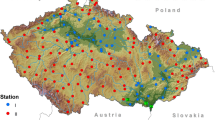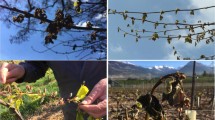Abstract
This study has, for the first time, analysed in detail the risk occurrences of the last spring frost, first fall frost and the length of the frost-free period during the growing season of vegetable crops at a high horizontal resolution of 10 km in the Elbe River lowland in the Czech Republic. The daily minimum air temperature from 116 grid points throughout the studied area for the period 1961–2011 was used. The daily values of minimum air temperature ranges of 0 to −1.1 °C, −1.2 to −2.2 °C and below −2.2 °C were considered to constitute mild, moderate and severe frost intensities, respectively. Firstly, the spatiotemporal variability of the date of the last spring frost, the date of the first fall frost and the length of the frost-free period in the Elbe River lowland is provided. Secondly, the estimation of the probability of a later date in the spring and an earlier date in the fall for various severe frost events and the length of the frost-free period is determined. Third, the changes in the timing of the last and first frosts of the three severities, as well as the length of the frost-free period, are evaluated. From 1961 to 2011, the Elbe River lowland has experienced a decrease in the number of frost days, while the length of the frost-free period between the last spring frost and the first fall frost has increased. The temporal evolution of the frost-free period anomalies displays two distinct periods: a shortening of the frost-free period in the 1960s and an intensified lengthening of the frost-free period since the 1980s. Whereas the latest spring frost has ended on an earlier date across the Elbe River lowland, the first frost date in the fall has generally been delayed to a later date. The dates of the last spring frost have advanced by −0.21 days per year on average. The fall dates are delayed up to 0.18 days per year, whereas the frost-free period is lengthening by up to 0.39 days per year on average. However, regional frost series suggests that the frost-free period exhibits a large amount of inter-annual variability. In terms of the growth of field vegetables, a late spring frost remains a risk factor, but the degree of risk has decreased. There is a 25 % chance of the occurrence of dangerous spring frosts during the planting of field vegetables after 3rd May, but after 15th May, the risk is only 10 %.








Similar content being viewed by others
References
Alcamo J, Moreno JM, Nováky B, Bindi M, Corobov R, Devoy RJN, Giannakopoulos C, Martin E, Olesen JE, Shvidenko A (2007) Europe. In: Parry ML, Canziani OF, Palutikof JP, van der Linden PJ, Hanson CE (eds) Climate change 2007: impacts, adaptation and vulnerability. Contribution of working group II to the fourth assessment report of the intergovernmental panel on climate change. Cambridge University Press, Cambridge, pp 541–580
Alexandersson A (1986) A homogeneity test applied to precipitation data. J Climatol 6:661–675
Alexandersson A (1995) Homogeneity testing, multiple breaks and trends. In: Proceedings of 6th international meeting on stat. Climatology, Galway, pp 439–441
Bootsma A (1994) Long term (100 year) climatic trends for agriculture at selected locations in Canada. Clim Chang 26:65–88
Brázdil R, Chromá K, Dobrovolný P, Tolasz R (2009) Climate fluctuations in the Czech Republic during the period 1961–2005. Int J Climatol 29(2):223–242
Didari S, Zand-Parsa S, Sepaskhah AR, Kamgar-Haghighi AA, Khalili D (2012) Preparation of frost atlas using different interpolation methods in a semiarid region of south of Iran. Theor Appl Climatol 108:159–171
Dodson R, Marks D (1997) Daily air temperature interpolated at high spatial resolution over a large mountainous region. Clim Res 8:1–20
Easterling DR, Peterson TC (1995) A new method for detecting undocumented discontinuities in climatological time series. Int J Climatol 15:369–377
Easterling DR, Horton B, Jones PD, Peterson TC, Karl RR, Parker DE, Salinger MJ, Razuvayev V, Plummer N, Jamason P, Folland CK (1997) Maximum and minimum temperature trends for the globe. Science 277:364–367
Easterling DR, Evans JL, Groisman PYA, Karl TR, Kunkel KE, Ambenje P (2000) Observed variability and trends in extreme climate events: a brief review. Bull Am Meteorol Soc 81:417–425
Ensor LA, Robeson SM (2008) Statistical characteristics of daily precipitation: comparisons of gridded and point datasets. J Appl Meteorol Climatol 47:2468–2476
Feng S, Hu Q (2004) Changes in agro-meteorological indicators in the contiguous United States: 1950–2000. Theor Appl Climatol 78:247–264
Forgač P, Molnar F (1967) Spring frost in Western Slovakia region. In: Proceedings of HMÚ, 9, SHMU, Bratislava, pp 31–86
Karl TR, Knight RW, Gallo KP, Peterson TC (1993) A new perspective on recent global warming: asymmetric trends of daily maximum and minimum temperature. Bull Am Meteor Soc 74:1007–1023
Maly I, Bartos J, Hlusek J, Kopec K, Petrikova K, Rod J, Spistitz P (1998) Field vegetable growing. Prague, Agrospoj 64 p. (in Czech)
Menzel A, Gert J, Rein A, Helfried S, Nicole E (2003) Variations of the climatological growing season (1951–2000) in Germany compared with other countries. Int J Climatol 23:793–812
Pejml K (1955) Development and current status of predictions night frosts during the growing season. Meteorol Bull 8(1):8–42 (in Czech)
Pejml K (1973) Secular evolution of frequency and intensity of spring frosts. In: Proceedings of HMÚ, 19, pp 8–42. (in Czech)
Plummer N, Salinger MJ, Nicholls N, Suppiah R, Hennessy KH, Leighton RM, Trewin B, Page ChM, Lough JM (1999) Changes in climates extremes over the Australian region and New Zealand during the twentieth century. Clim Chang 42:183–202
Potop V (2010) Temporal variability of daily climate extremes of temperature and precipitation in the middle Polabí (Elbeland) lowland region. Sci Agric Bohem 41:140–148
Potop V (2013) The evolution of the assortment and yield of vegetable crops in relation to climate in Polabí. In: Proceedings of influence of abiotic and biotic stresses on properties of plants 2013. Praha 13.–14.2.2013, pp 198–201. (in Czech)
Potop V, Koudela M, Možný M (2011) The impact of dry, wet and heat episodes on the production of vegetable crops in Polabí (River Basin). Sci Agric Bohem 42(3):93–101
Potop V, Možný M, Soukup J (2012) Drought evolution at various time scales in the lowland regions and their impact on vegetable crops in the Czech Republic. Agric For Meteorol 156:121–133
Potop V, Türkott L, Zahradníček P, Štěpánek P (2013) Evaluation of agro-climatic potential of Bohemian plateau (České tabule) for growing vegetables. Meteorol Bull 66(2):42–48 (in Czech)
Potter KW (1981) Illustration of a new test for detecting a shift in mean in precipitation series. Mon Weather Rev 109:2040–2045
Rahimi M, Hajjam S, Khalili A, Kamalid GA, Stigter CJ (2007) Risk analysis of first and last frost occurrences in the Central Alborz Region, Iran. Int J Climatol 27:349–356
Robeson SM (2002) Increasing growing-season length in Illinois during the 20th century. Clim Chang 52:219–238
Scheifinger H, Menzel A, Koch E, Peter Ch (2003) Trends of spring time frost events and phenological dates in Central Europe. Theor Appl Climatol 74:41–51
Šercl P, Lett P (2002) The calculation of the grid precipitation in the GIS environment (using ArcView Spatial Analyst). User’s Guide Version 2.0.1. ČHMÚ, OPV, Praha. (in Czech)
Shen SSP, Yin H, Cannon K, Howard A, Chetner S, Karl TR (2005) Temporal and spatial changes of the agroclimate in Alberta, Canada, from 1901 to 2002. J Appl Meteor 44:1090–1105
Štěpánek P (2010) ProClimDB—software for processing climatological datasets. CHMI, regional office Brno. http://www.climahom.eu/ProcData.html
Štěpánek P, Zahradníček P, Brázdil R, Tolasz R (2011a) Methodology of data quality control and homogenization of time series in climatology. Praha, p 118
Štěpánek P, Zahradníček P, Huth R (2011b) Interpolation techniques used for data quality control and calculation of technical series. An example of Central European daily time series. Idöjaras 115:87–98
Stibral J (1966) Frequency of frosts during flowering apple trees. Meteorol Bull 19(6):177–179 (in Czech)
Tait A, Zheng X (2003) Mapping frost occurrence using satellite data. J Appl Meteorol 42:193–203
Tolasz R et al. (2007) Atlas podnebí Česka. Climate Atlas of Czechia. ČHMÚ Praha, Univerzita Palackého v Olomouci, Praha-Olomouc, p 254
Thom HCS (1959) The distribution of freeze-date and freeze-free period for climatological series with freeze less years. Mon Weather Rev 87:136–144
Willmott CJ, Matsuura K (1995) Smart interpolation of annual averaged air temperature in the United States. J Appl Meteorol 34:2577–2586
WMO (1963) Protection against frost damage, WMO-No. 133. WMO, Geneva
Acknowledgments
This research was supported by S grant of MSMT CR and project CZ.1.07/2.3.00/20.0248. The authors are grateful to the editor V. Schenk and two anonymous reviewers for their constructive comments and suggestions.
Author information
Authors and Affiliations
Corresponding author
Rights and permissions
About this article
Cite this article
Potop, V., Zahraniček, P., Türkott, L. et al. Risk occurrences of damaging frosts during the growing season of vegetables in the Elbe River lowland, the Czech Republic. Nat Hazards 71, 1–19 (2014). https://doi.org/10.1007/s11069-013-0894-5
Received:
Accepted:
Published:
Issue Date:
DOI: https://doi.org/10.1007/s11069-013-0894-5




